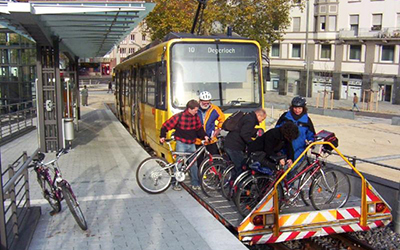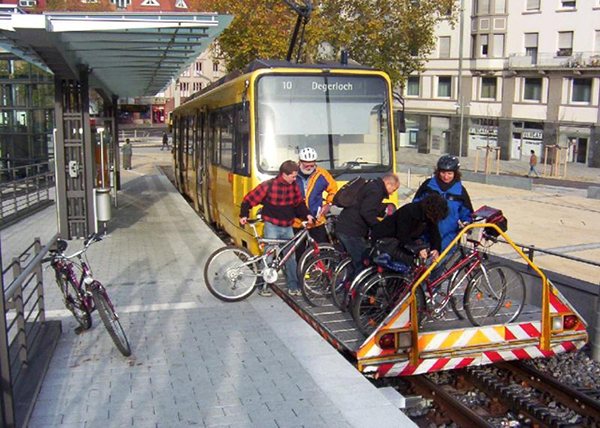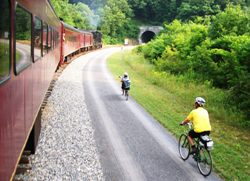Magazine urges agency to build for future


Flatcar of the Future: This stunningly simple Stuttgart system for making urban cycling viable is perfectly suited to rural ‘rail with trail’ infrastructure. image Montenbaik.com
The following submission is that of the Mahurangi Magazine, prepared by Cimino Cole, editor, with the support of John Timmins, publisher. The magazine thanks its many readers who have expressed support for the need to protect the harbourscape, and the need to build other than motorways.
Mahurangi Magazine motorway submission
Passing to the west of Warkworth and to the east of Wellsford
Bypasses, rather than continuous motorway or expressway, should be built around Warkworth and Wellsford—Warkworth’s could have been built already, rather than the extravagantly non-strategic four-laning currently nearing completion.
Warkworth should be bypassed to the west for the reasons the agency has cited: To avoid additional length and the need to cross the Mahurangi River. In addition to a river crossing, an eastern bypass would need to traverse steep terrain and would have a major aesthetic impact on the Wilson Cement Works heritage area.
While Wellsford is beyond the mandate of the Mahurangi Magazine, most with affection for the place and its people must have reflected on how singularly the highway defines the town as an impediment to travellers, rather than as a refreshing place to break a journey.
Ironically, the pedestrian underpass adjacent Wellsford’s schools, which was denied for so long, would not have been necessary had the town been bypassed decades ago as it deserved to be.
Tellingly, the railway passes to the east of Wellsford—the natural side on which a bypass should be built.
The advantages/disadvantages of an access point to the north or west of Warkworth and to the east of Wellsford
Bypasses, rather than continuous motorway or expressway should be built around Warkworth and Wellsford.
The benefit of bypasses, over motorway, is that full interchanges can be avoided. This facilitates access ways that more sympathetically integrate the towns’ roads. Travellers can detour through towns, and potentially stop for refreshment. The single access and egress demanded by motorways, discourages travellers from visiting towns that would other be natural places to break a journey. The artificial wayside food and fuel stops offer only an impoverished option and provide little to refresh the minds of drivers.
If a motorway is built beside Warkworth, the access should be to the north so as to relieve town roads of traffic to and from Goat Island, Leigh, Matakana Ōmaha and the Mahurangi peninsula. Warkworth’s ability to attract visitors is currently seriously compromised in peak holiday periods.
Holiday travellers crawling through Warkworth are understandably reluctant relinquish their place in the queue to detour into the town, and face a lengthy wait to rejoin the highway. Access from a motorway will increase the attractiveness of Warkworth to visitors, but for reasons that will be expanded further a motorway should not be built.
Wellsford similarly would benefit from a bypass designed to entice travellers to break their journeys, rather than to grit teeth endure the delay to their progress.
Any other matters you think should be thought about in the overall design of the new highway
The raison d’être for the Mahurangi Magazine is the Mahurangi landscape: A harbourscape of outstanding natural beauty, a million miles from the metropolis.

Rail Trail of the Future: Increasingly, internationally, the move is to rail with trail, rather than cannibalise perfectly useable railways. photograph Rails-to-Trails Conservancy
The need for better protection from development impacts is manifest from the erosion of the rural look and feel of the scenic Mahurangi West ridge road. Concern for the added impact arising from the completion of the motorway to the Pūhoi River has been articulated for some time and was a driver for, and has been included in, the Mahurangi Action Plan.
To date, the development impact has been softened by the global economic downturn.
The greatest protection for the harbourscape, is the status quo: That it remains signalled that the motorway will be extended northward, and for there to be no direct access to it from Mahurangi West and Pūhoi. This does not obviate the need for more specific landscape protection, as recorded in the Mahurangi Action Plan.
The Mahurangi Magazine, however, cannot in good conscience advocate for further motorway extension, despite it being conducive to reducing local development pressure.
Anthropogenic global warming dictates that every practicable measure must be taken to reduce carbon dioxide emission. The singular means of achieving this to discourage daily long-distance commuting, and to regulate for moving freight by rail.
Global warming, aside from its threat to global security, is forecast to bring more severe and more frequent drought, and more severe and more frequent deluges to Auckland and Northland. Urgent mitigation is both a moral and practical imperative.
Road transport is currently the top driver of anthropogenic global warming. It is ranked ahead of electricity production, most of which is also fossil-fueled, but only because it is relatively aerosol-free, compared to coal-fired power plants. Continued building of motorways is incompatible with Aotearoa’s clean–green aspirations and marketing.
The economies of the communities between Pūhoi and Wellsford, and in Northland, will ultimately be more resilient if based on a low-carbon infrastructure, rather than be encouraged to increasing rely on fossil or bio fuel.
If the motorway is extended northward, bus bays should be provided at Mahurangi West, but otherwise private vehicle access should be via the existing highway. This should probably also be the case at Pūhoi, although one reader suggests that something less than a full interchange might provide ‘a middle ground’.
Clearly, further improvements are needed to State Highway 1. An example in the Mahurangi catchment is where the two-lane Pohuehue viaduct substantially diminishes the utility of the passing lanes, while multiplying the hazard.
A decade and a half ago, with its plans labelled ‘Albany to Pūhoi Motorway Project’, the former Transit New Zealand created the clear expectation of on-going motorway access at Pūhoi. By suddenly signalling that this access might cease, the transport agency has precipitated an unprecedentedly outraged, and often vitriolic, community backlash.
This widespread outburst has made it extremely uncomfortable for members of the community to express strong and long-held concerns for growth pressure—classic ‘if you are not for us, you are against us’ polarisation.
A manifestation of this was the exclusion of any community representative to address ‘other than pro-access’ issues from the 29 July meeting between the agency, the community and the councils.
While it has focussed mostly on present and potential growth pressure resulting from motorway access, the critical short to medium collateral issue is sediment generation. Motorway construction would unavoidably add to the harbour’s already elevated sediment accumulation rate. And if direct access were to be provided, the ensuing development would further add to that impact.
The bulk of any route considered between Pūhoi and The Dome will be within the Mahurangi catchment. Thus the sediment generation impact on the catchment will more depend on the construction methods than the actual route chosen. Viaducts and tunnels should be considered ahead of cut and fill. But because the particular value of the Mahurangi landscape is the respite it provides Aucklanders from the metropolis, no motorway route should be considered within the visual catchment of the harbour.
To summarise, there would be considerable direct and indirect impacts on the Mahurangi catchment from the proposed motorway construction.
The direct impacts include sediment generation impact on benthic communities and, depending on route, loss of value from an area of outstanding natural beauty.
The indirect impact is the wilful contribution to anthropogenic global warming, which, in any event, will increasingly ravage the vulnerable Mahurangi catchment.
The Mahurangi Magazine urges the agency to build infrastructure for the future, not a fossil-fuel-hungry commuter and holiday highway of the past.
